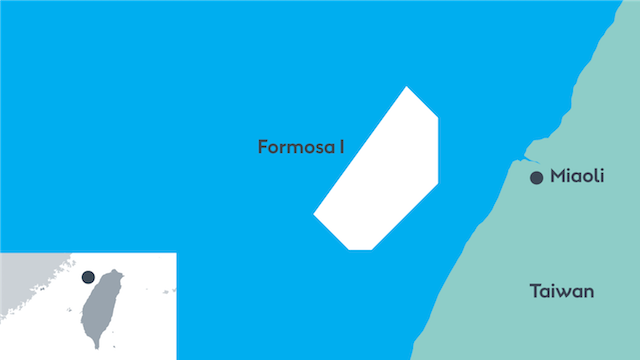By Ilaria Valtimora, Contributor
Recent political changes have shaken Taiwan, and could put at risk the development and growth of its nascent offshore wind market.
On 17th November, Taiwan’s ruling Democratic Progressive Party (DPP) lost significant ground to opposition party Kuomintang in local elections, losing seven of its 13 mayoral and county magistrate seats. For many businesses and onlookers in Taiwan, this was a shock.
It’s a blow for investors in the wind sector too. Since coming to power in 2016, the DPP has pursued a clean energy agenda. It has pledged to phase out nuclear energy by 2025 and has been planning for 20 percent of Taiwan’s electricity to come from renewable sources by the same year. Government support for a ‘greener’ economy has led to favourable policies for renewables, particularly generous feed-in tariffs for offshore wind.
Taiwan has excellent conditions for offshore wind. Wind speeds of 12m/s in the Taiwan Strait, and guaranteed power prices of TWD 5,849 / MWh (€167 / MWh, US $189 / MWh), have attracted the attention of international wind developers and investors. As a result, in April and June, the government awarded firms the right to connect offshore wind projects totalling 5.5 GW to the national grid.
Related: The Asia-Pacific Offshore Wind Sector Just Achieved a ‘Breakthrough Moment’asvdqeextwewfvdbbxrsfturdcb
These favourable conditions have made Taiwan a very attractive investment opportunity, despite risks including natural catastrophes and political aggression from China.
But the shift in public opinion from the DPP towards Kuomintang, which has vocally criticised the DPP’s commitment to offshore wind, is an indication that voters are not wholly supportive of the DPP’s clean energy agenda. In a referendum that coincided with the elections, 59.5 percent of voters chose to ditch the nuclear phase-out deadline of 2025.
This doesn’t mean that the change won’t happen, but it will take longer. This also removes an important driver for replacement energy sources including wind farms.
In addition, the country’s ministry of economic affairs announced in November that offshore wind feed-in-tariff prices would be cut by 12.7 percent next year, to TWD 5,106 / MWh (€146 / MWh; US $165 / MWh). This affects projects that won the right to be connected to the grid in 2018, but which will only be able to secure their power purchase agreement this year. These represents over 86 percent of the capacity of the 5.5 GW projects that secured the right to be built last year.
In fact, only two projects totalling 736 MW have been able to secure power purchase agreements at pre-agreed rates in December. Taiwanese utility Taipower signed PPAs last month with the companies behind the 376-MW Formosa 2 offshore wind farm, which has been developed by Macquarie Capital (75 percent) and Swancor (25 percent); and at Wpd’s 360-MW Guanyin scheme.
This means that while Macquarie, Swancor and Wpd have secured a PPA with higher 2018 feed-in-tariff prices, owners and developers of projects totalling over 4.7 GW won’t – unless the government has a change of heart.
What Does This Mean For Investors?
Retrospective tariff cuts are never welcome, as they undermine investment plans.
Ørsted has been the most vocal company about this so far. The Danish giant missed a deadline of 2nd January to sign a PPA with Taipower for its 900-MW Changhua 1 and 2 projects at the higher 2018 rate. It is now looking at the lower 2019 level.
As a result, the company has paused all of its project activities in the country. Martin Neubert, CEO of Ørsted’s offshore activities, said the company is “very concerned about the suggested feed-in tariff level for 2019 as well as the newly-proposed cap on annual full-load hours.”
We wouldn’t be surprised if some of the other affected developers were to follow Ørsted’s lead, which could pile more pressure on the government.
In total, the offshore wind developments that won support last year are expected to attract investment of up to $22bn, which would benefit both the local industries and economy. But that is now at risk, all because the government thinks it can offer PPAs at lower established market prices for projects with emerging market risks.
The Taiwanese offshore wind market lacks infrastructure. It will take big money to build a supply chain up to the task of supporting major offshore projects.
Also, the unique geographical and weather conditions in Taiwan require bespoke technology: for example, MHI Vestas announced that it was ‘typhoon-proofing’ its V164 turbines in preparation for the Taiwanese market this year. These are major investments and so certainty for investors is a must.
The balance of risk and reward is always crucial for attracting and retaining investor interest. The Taiwanese government needs to decide soon about whether to honour its previous promises. This is set to prove crucial to the growth of offshore wind in Taiwan.
Ilaria Valtimora is associate editor at A Word About Wind, a membership organization that provides intelligence, insight and connections to senior industry decision makers.





